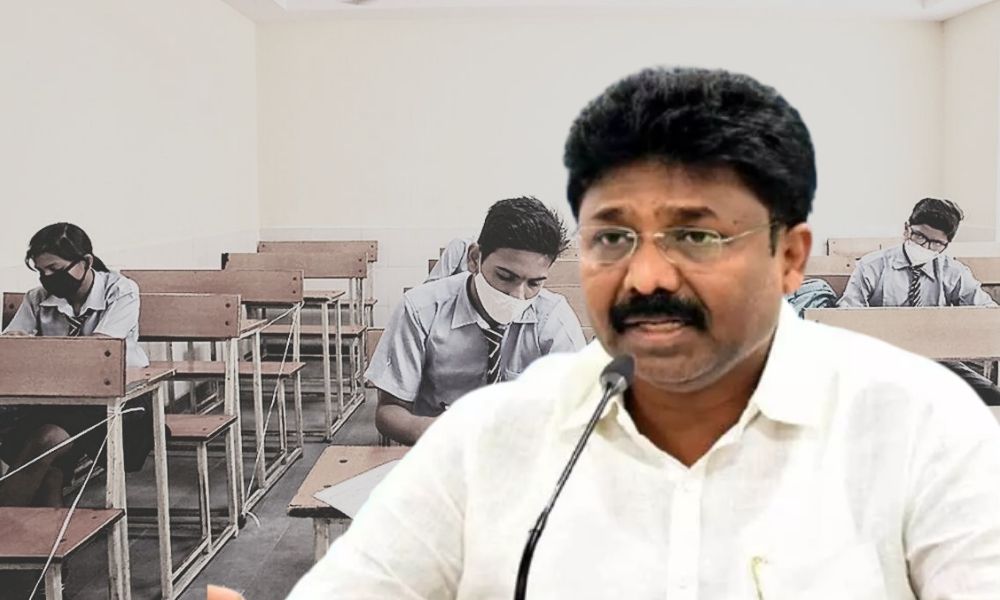
Image Credit: The Indian Express, Wikipedia
Why Are Children Shifting From Private To Government Schools In Andhra Pradesh?
Writer: Ratika Rana
Her primary objective is to inform, promote, educate and cultivate readers through writing.
Andhra Pradesh, 25 July 2021 1:41 PM GMT | Updated 25 July 2021 2:05 PM GMT
Editor : Madhusree Goswami |
A mountain girl trying to make it big in the city. She loves to travel and explore and hence keen on doing on-ground stories. Giving the crux of the matter through her editing skills is her way to pay back the journalism its due credit.
Creatives : Ratika Rana
Her primary objective is to inform, promote, educate and cultivate readers through writing.
More than 2 lakh children shifted from private schools to government schools in Andhra Pradesh, and 60,000 of have them dropped out. Increasing enrollments in government schools have been credited to the development of school infrastructure under the Nadu-Nedu programme.
Andhra Pradesh has been witnessing a massive shift of students from private schools to government schools this academic year (2020-21). The data from the state's education department shows that while 8,488 students moved from government schools to private schools, 2,02,599 students moved from private to government schools. The enrollment is still on, and while the current strength in government schools in the state has already reached 72,33,040, whereas private schools have held on to 10 lakh students. Apart from this, 60,253 children dropped out of the education system in the state. The shift from private to government schools observed in other states has coincided with the coronavirus pandemic and its consequent economic distress.
Increase In Dropouts
The Indian Express quoted officials stating that the number of dropouts in several districts was three to four times more than in previous years. In 2019-2020, the number of dropouts in Vishakhapatnam was 19,800 compared to the current year's 36,016 students. In East Godavari, the numbers increased from 3,800 to 36,237 dropouts during the same period. In Kurnool, the numbers rose from less than 10,000 in 2019-20 to 42,328 in the academic year ending 2021. The education department took into consideration the students who had taken transfer certificates from one school but did not enrol in other schools as dropouts. Education Minister Audimulapu Suresh said that the government is looking to trace the students who dropped out to get them back to education before schools reopen in mid-August. Among those who dropped out of school, girls are in a majority. The minister said there could be various reasons for the jump in dropout rates like prolonged closure of schools, loss of income in the family or migration to hometowns. Officials from the Sarva Shiksha Abhiyan have also said that several families have shifted from cities to their villages, thus, displacing students.
Mana Badiki Podam is a mobile application developed by the government on which house-to-house surveyors that include teachers and Anganwadi workers upload dropouts data. After that, an online data monitoring system called Child Info DropBox helps track them. The scenario in other states is somewhat similar. In Haryana, 89,138 students have made the shift from private to government schools, whereas, in Punjab, more than 33,000 students have made the same shift.
Increasing enrollments in government schools have been credited to the development of school infrastructure under the Nadu-Nedu programme. Official sources said that the government took up the reforms to uplift education and the results are visibly positive. As a measure of spreading awareness about the quality of education in government schools, many student/parent oriented schemes have been implemented since 2019. Nadu-Nedu (Then-Now) was an exercise by the state government to revamp 45,000 schools across the state. Apart from upgrading its infrastructure, every school was to have an English lab for a modern learning experience.
Several Welfare Schemes Launched By The Government
Jagananna Ammavodi and Jaganna Vidya Kanuka also increased admissions. Jagananna Ammavodi is a flagship scheme of the Andhra Pradesh government. Under the project ₹ 15,000 is given annually to the mothers of students studying in classes 1 to 12 in government schools. The Jagana Vidya Kanuka scheme reduces pressure on low-income families by providing children with school bags, uniforms, boots, socks, a belt and other necessities. These uplifting schemes have helped reduce the dropout rates. Moreover, these programs have increased the confidence the students and parents in the state's education system.
The budget allocations in Andhra Pradesh towards education had been declining since 2015-16. In the 2017-18 survey by the National Sample Survey Organization (NSSO), the literacy rate in the state was struggling at 66.4 per cent, which was lesser than Bihar (70.9 per cent). The significant percentage of techies that the state produces tend to cloud this harsh reality. The state ranked 31st amongst all states and Union Territories in literacy in the Census of 2011. When the Telugu Desam Party was in power, the shutting down of several schools led to the mushrooming of various private schools. The trend of a shift in education was widely observed in the state's rural and urban areas. One of the main reasons the YSR government could win 151 seats in the 175 member assembly was their promise of fee reimbursement. The state promised schemes like Nadu-Nedu, Jagannana Gorumudda, Jagananna Vidya Kanuka. The government set aside ₹3,500 crore for the Nadu-Nedu scheme, ₹ 1,200 crore for Jagananna Gorumudda, ₹ 750 crore for Vidya Kanuka and an additional ₹ 1,973 crore for higher education. Despite all the progressive schemes, the government allocated only 10.7 per cent of its state budget to education. A recommendation by the Kothari Commission mentioned that states should set aside 30 per cent of their annual budget, and the Union should allocate 10 per cent of its annual budget for education.
Almost 50% of Private Schools Have Shut Shop
After the lockdown was announced in March 2020, the schools reopened in November only to close again. The private schools that could not pay their teachers had to shut shop. As the children turned towards government schools, there was a shortage of textbooks. However, the education ministry tacked the challenge because a buffer stock of 5 per cent of textbooks was already printed in 2019-20. The Joint Secretary of Andhra Pradesh Private Schools Management Association (APPSMA), N. Vishwanatha Reddy, said that almost 10 to 30 per cent of small private schools in urban areas and half of them in rural areas had shut shop. He mentioned that if the pandemic continued in the same fervour till June-July, 50 per cent of the schools would be closed.
The number of students showinga growing interest in competitive exams like the Union Public Service Commission has put pressure on the government to implement the CBSE syllabus in schools. Therefore, the state plans to educate students on the guidelines of CBSE from classes I to VII by next year, and the plans are to move classes VIII to XII to CBSE by 2024. While returning to normalcy remains uncertain, the massive move of students from private to government schools is a good sign for the government. It now becomes the onus of the party in power to provide adequate infrastructure and participation to students to facilitate them with the required skills.
Also Read: Now Pay More To Keep Your Old Cars: All About Vehicle Scrappage Policy
 All section
All section














